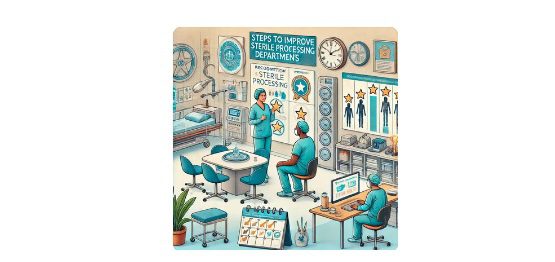Improving the culture within sterile processing departments
(SPDs) is crucial for attracting more candidates to the technician
positions. Here are some steps that can be taken:
1. Enhance Recognition and Respect
• Raise Awareness: Educate other healthcare professionals and leadership on the
critical role of SPDs in patient safety. Highlight successes and the importance of
sterile processing in preventing infections.
• Recognition Programs: Implement employee recognition programs that reward
excellent performance, adherence to protocols, and contributions to patient
outcomes. Publicly acknowledge achievements to boost morale.
2. Offer Competitive Compensation and Benefits
• Competitive Salaries: Ensure that salaries for sterile processing technicians are
competitive with industry standards, reflecting the importance and complexity of
the role.
• Comprehensive Benefits: Provide comprehensive benefits packages that include
health insurance, retirement plans, and opportunities for bonuses or incentives tied
to performance.
3. Invest in Education and Professional Development
• Certification Support: Offer financial assistance for certification programs like the
Certified Registered Central Service Technician (CRCST) or Certified Sterile
Processing and Distribution Technician (CSPDT). Encourage continuous learning.
• Career Advancement Paths: Create clear career advancement paths within the
SPD, such as roles in leadership, training, or specialization in certain types of
equipment or procedures.
4. Improve Working Conditions
• Ergonomic Workspaces: Design workspaces that minimize physical strain,
including ergonomic workstations, proper lighting, and sufficient space for tasks.
• Adequate Staffing: Ensure adequate staffing levels to prevent burnout and
excessive workloads, which can contribute to job dissatisfaction and high turnover.
5. Foster a Positive Work Environment
• Team-Building Activities: Organize regular team-building activities to foster
camaraderie and a sense of belonging among SPD staff.
• Open Communication: Encourage open communication between staff and
management. Regularly solicit feedback from technicians and take action on their
concerns and suggestions.
6. Enhance Job Satisfaction
• Job Rotation: Offer job rotation opportunities within the SPD to prevent monotony
and allow technicians to develop a diverse skill set.
• Autonomy and Responsibility: Empower technicians by giving them more
autonomy and responsibility in decision-making processes, such as protocol
development or equipment selection.
7. Promote Work-Life Balance
• Flexible Scheduling: Provide flexible work schedules or shift options to
accommodate personal needs and reduce stress.
• Mental Health Support: Offer mental health resources, such as counseling
services, to support the well-being of SPD staff.
8. Leverage Technology and Innovation
• Modern Equipment: Invest in modern sterilization equipment and technology to
reduce the manual workload and make the job more appealing to tech-savvy
candidates.• Automation: Introduce automation where possible to improve efficiency and
reduce repetitive tasks, making the role more attractive and less physically
demanding.
9. Community and Outreach
• Outreach Programs: Partner with local schools, community colleges, and training
programs to promote sterile processing as a viable and rewarding career option.
• Internships and Apprenticeships: Develop internship or apprenticeship programs
that allow prospective technicians to gain hands-on experience and a better
understanding of the profession.
10. Build a Strong Team Culture
• Mentorship Programs: Implement mentorship programs where experienced
technicians guide new hires, fostering a supportive environment and aiding in skill
development.
• Inclusive Culture: Promote an inclusive culture that values diversity and ensures
that all team members feel valued and respected.
By focusing on these areas, sterile processing departments can create a more attractive
and supportive environment that not only retains current staff but also attracts new
candidates to the field.



